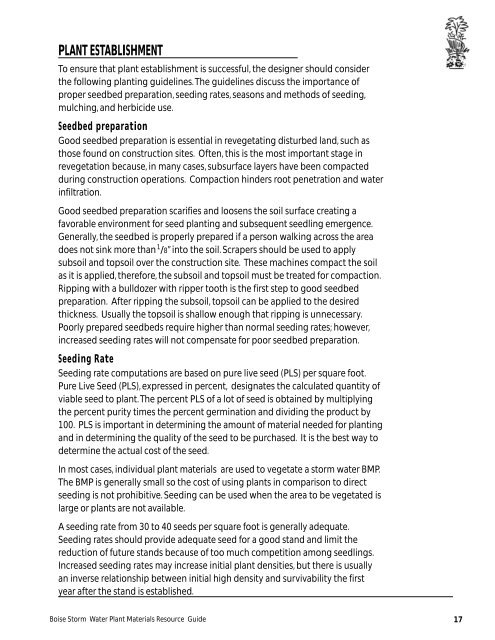Storm Water Plant Materials A Resource Guide
Storm Water Plant Materials A Resource Guide
Storm Water Plant Materials A Resource Guide
You also want an ePaper? Increase the reach of your titles
YUMPU automatically turns print PDFs into web optimized ePapers that Google loves.
PLANT ESTABLISHMENT<br />
To ensure that plant establishment is successful, the designer should consider<br />
the following planting guidelines. The guidelines discuss the importance of<br />
proper seedbed preparation, seeding rates, seasons and methods of seeding,<br />
mulching, and herbicide use.<br />
Seedbed preparation<br />
Good seedbed preparation is essential in revegetating disturbed land, such as<br />
those found on construction sites. Often, this is the most important stage in<br />
revegetation because, in many cases, subsurface layers have been compacted<br />
during construction operations. Compaction hinders root penetration and water<br />
infiltration.<br />
Good seedbed preparation scarifies and loosens the soil surface creating a<br />
favorable environment for seed planting and subsequent seedling emergence.<br />
Generally, the seedbed is properly prepared if a person walking across the area<br />
does not sink more than 1 /8” into the soil. Scrapers should be used to apply<br />
subsoil and topsoil over the construction site. These machines compact the soil<br />
as it is applied, therefore, the subsoil and topsoil must be treated for compaction.<br />
Ripping with a bulldozer with ripper tooth is the first step to good seedbed<br />
preparation. After ripping the subsoil, topsoil can be applied to the desired<br />
thickness. Usually the topsoil is shallow enough that ripping is unnecessary.<br />
Poorly prepared seedbeds require higher than normal seeding rates; however,<br />
increased seeding rates will not compensate for poor seedbed preparation.<br />
Seeding Rate<br />
Seeding rate computations are based on pure live seed (PLS) per square foot.<br />
Pure Live Seed (PLS), expressed in percent, designates the calculated quantity of<br />
viable seed to plant. The percent PLS of a lot of seed is obtained by multiplying<br />
the percent purity times the percent germination and dividing the product by<br />
100. PLS is important in determining the amount of material needed for planting<br />
and in determining the quality of the seed to be purchased. It is the best way to<br />
determine the actual cost of the seed.<br />
In most cases, individual plant materials are used to vegetate a storm water BMP.<br />
The BMP is generally small so the cost of using plants in comparison to direct<br />
seeding is not prohibitive. Seeding can be used when the area to be vegetated is<br />
large or plants are not available.<br />
A seeding rate from 30 to 40 seeds per square foot is generally adequate.<br />
Seeding rates should provide adequate seed for a good stand and limit the<br />
reduction of future stands because of too much competition among seedlings.<br />
Increased seeding rates may increase initial plant densities, but there is usually<br />
an inverse relationship between initial high density and survivability the first<br />
year after the stand is established.<br />
Boise <strong>Storm</strong> <strong>Water</strong> <strong>Plant</strong> <strong>Materials</strong> <strong>Resource</strong> <strong>Guide</strong><br />
17

















